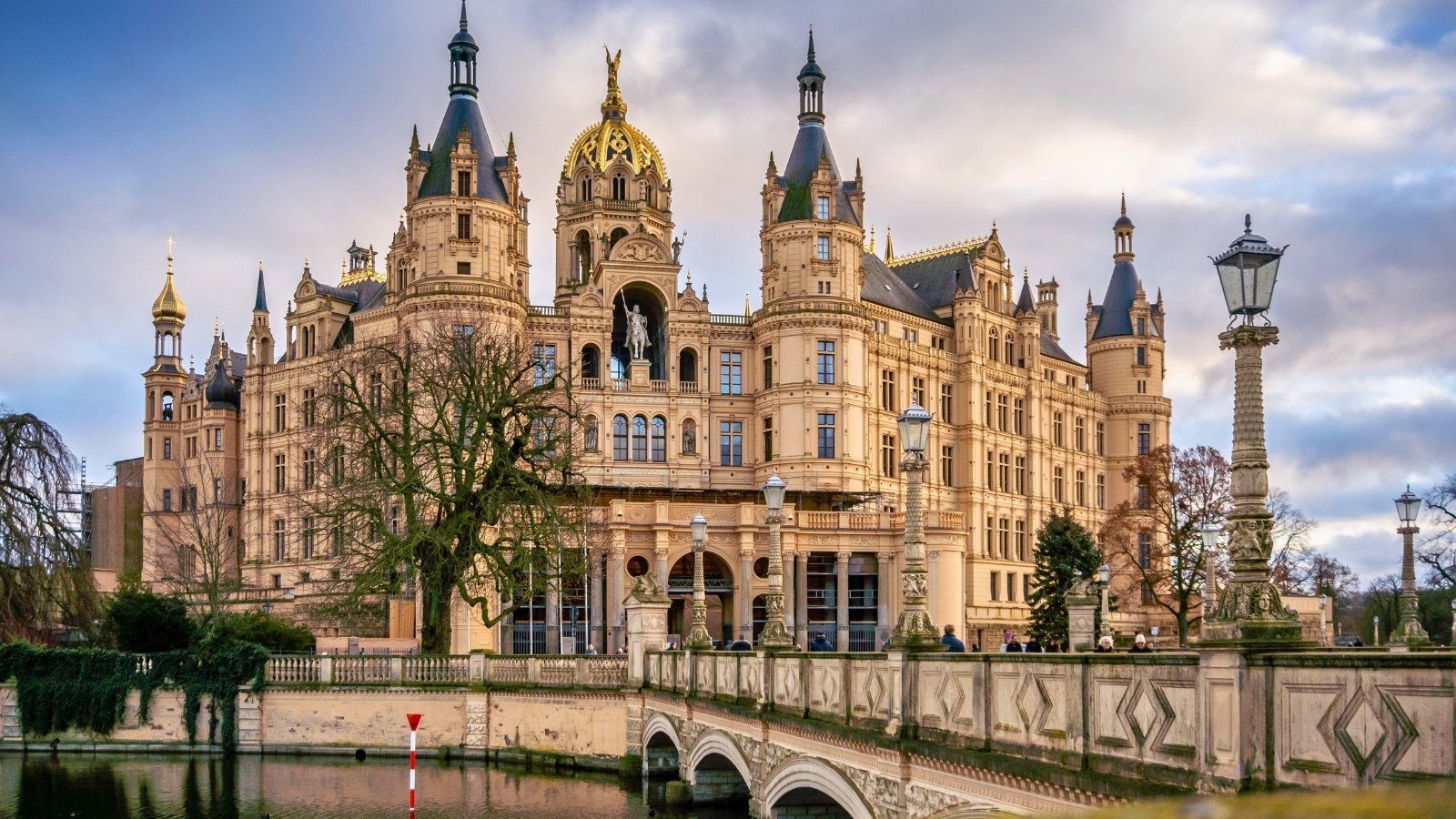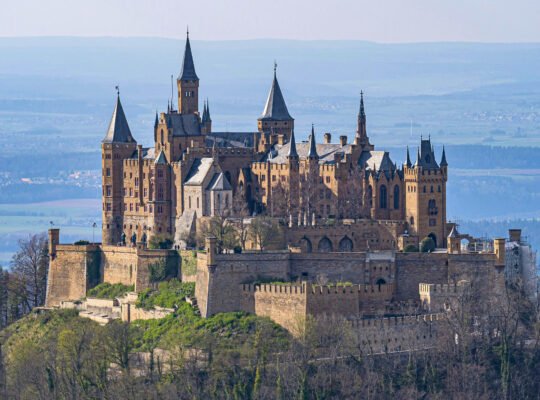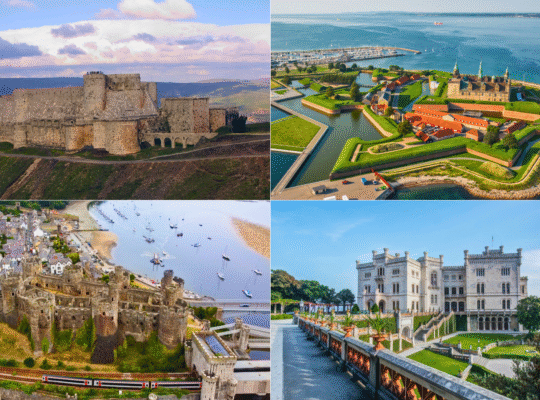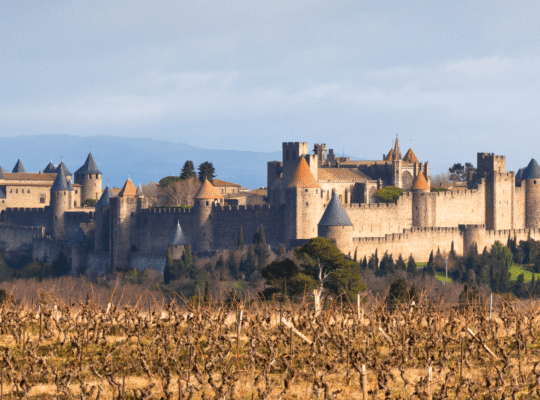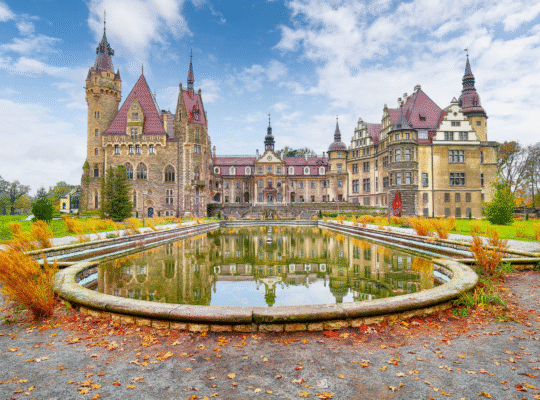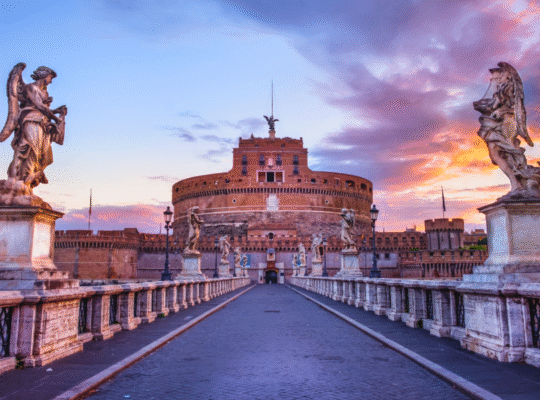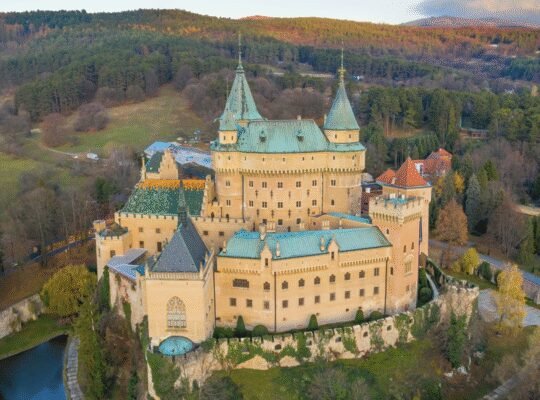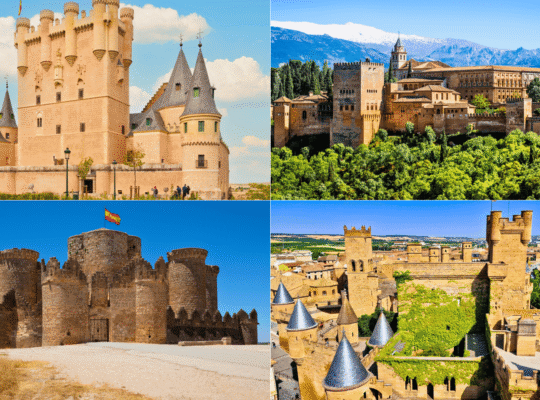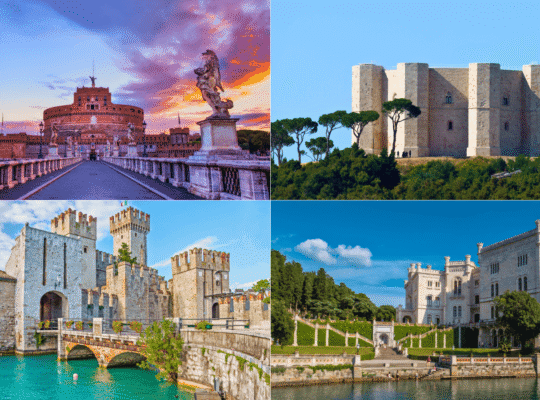There are castles, and then there’s Schwerin Castle—a place so dreamlike that many call it the “Neuschwanstein of the North.” Rising from its own island in the middle of Lake Schwerin, its golden turrets shimmer above the water, catching the light like something from a storybook. You don’t just stumble across this place; you see it long before you reach the gates, and the first glimpse almost always stops travelers in their tracks.
For centuries, this was the seat of dukes and grand dukes of Mecklenburg, a power center that blended politics, wealth, and art into one glittering package. Yet Schwerin Castle is more than just another royal residence. Local lore whispers of the Petermännchen, a mischievous little ghost said to roam the halls at night, guarding the castle and occasionally playing tricks on unwelcome visitors. Whether you believe in the spirit or not, it adds a certain thrill when you wander its grand rooms or pause in the shadow of its towers.
The castle we see today took shape in the mid-19th century, a masterwork of Romantic historicism with hints of Renaissance and Baroque woven into its design. Walk inside, and you’ll be greeted by gilded chambers, sweeping staircases, and walls lined with portraits of rulers who once shaped the destiny of northern Germany. Step outside, and manicured gardens spill into the shimmering lake, making it hard to tell where architecture ends and nature begins.
What makes Schwerin Castle truly special is the way it balances grandeur with warmth. It’s stunning, yes—but it’s also surprisingly approachable, with walking paths, boat rides, and museum exhibitions that invite you to linger. And if you’re lucky enough to visit during the annual Schlossfestspiele, the open-air opera festival, you’ll see the castle transformed into a stage as magical as any in Europe.
This is not just a castle to admire from afar. Schwerin Castle is a place to experience, to breathe in, and to remember long after you’ve left the island.

Quick Facts
📍 Location: Schwerin, Mecklenburg-Vorpommern, Germany
🏗️ Construction Period: Origins in the 10th century; major reconstruction 1845–1857
🏰 Architectural Style: Romantic historicism with Renaissance and Baroque influences
🎭 Famous For: Nicknamed the “Neuschwanstein of the North,” home of the Mecklenburg dukes, and the legend of the Petermännchen ghost
👑 Notable Figures: Duke Niklot (founder of the original fortress), Grand Duke Friedrich Franz II (key figure in 19th-century reconstruction), architects Gottfried Semper and Friedrich August Stüler
🏆 UNESCO Status: On Germany’s tentative list for UNESCO World Heritage status
🌐 Official Website: https://www.mv-schloesser.de/de/location/schloss-schwerin/

History & Legends
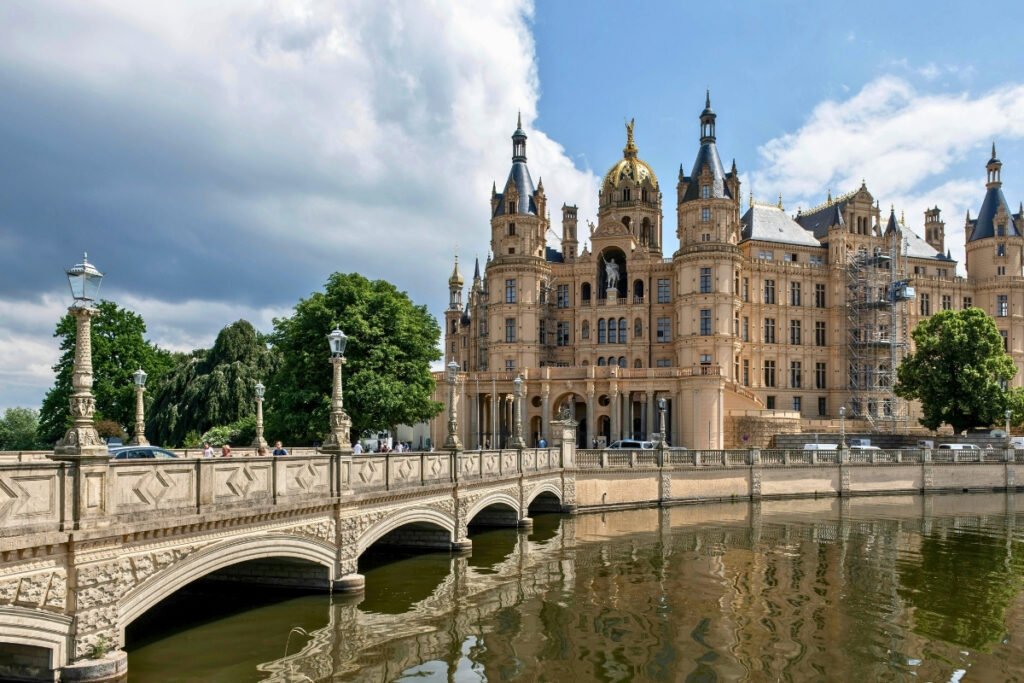
Schwerin Castle’s story begins long before its gleaming towers became a postcard image for northern Germany. The site has been a seat of power for over a thousand years, with roots stretching back to a Slavic fortress built around 965. At that time, the Obotrite tribe, under their prince Niklot, controlled much of the region, and Schwerin Island provided the perfect natural stronghold. Surrounded by water, it was both defensible and commanding—a place meant to project authority as much as to secure it.
When Germanic expansion into Slavic lands intensified in the 12th century, the fortress fell, and Schwerin came under Saxon control. A new castle rose in its place, and the town of Schwerin began to grow around the island, laying the foundation for what would become a ducal capital. By the late Middle Ages, the castle had firmly established itself as the residence of the Dukes of Mecklenburg, whose dynasty would shape its destiny for centuries.
The Medieval Fortress
Early versions of Schwerin Castle bore little resemblance to today’s ornate palace. It was a fortress first and foremost—massive stone walls, towers for defense, and a keep designed to withstand sieges. Still, even in those times, rulers sought to add touches of grandeur. Gothic windows, chapels, and audience halls began to appear, signaling that this was not just a military outpost but a seat of power and ceremony.
Fires, wars, and political shifts left their marks, and each rebuilding layered new styles onto the old. By the 16th century, Renaissance influences had begun to transform the castle, with arcades, ornamental gables, and more decorative facades appearing. The transition mirrored the ambitions of the dukes, who wanted Schwerin to be not just a fortress but a showpiece of their wealth and sophistication.
The 19th-Century Transformation
The most dramatic change came in the mid-1800s. Grand Duke Friedrich Franz II wanted a residence that would rival the great palaces of Europe. Between 1845 and 1857, Schwerin Castle underwent a complete transformation, led by renowned architects Friedrich August Stüler, Gottfried Semper, and others.
They chose a Romantic historicist style, blending Renaissance revival with elements of Baroque. The result is the fairytale-like vision we see today—countless turrets, intricate facades, and a golden dome that gleams in the sunlight. The redesign turned Schwerin Castle into a symbol of ducal pride and a statement piece for the era. It wasn’t just about creating a home; it was about crafting an icon.
Political Shifts and Modern Role
The castle’s function changed dramatically after the monarchy’s decline in the early 20th century. Following World War I, when German dukes lost their political power, Schwerin Castle was repurposed. It became a museum, a government building, and eventually, during the Cold War, the seat of the East German regional parliament for Mecklenburg.
Since German reunification, Schwerin Castle has served as both a cultural treasure and a working building. Today, it houses the state parliament of Mecklenburg-Vorpommern while also functioning as a museum open to visitors. This dual role keeps the castle alive—not a frozen relic of the past, but a space still deeply embedded in the life of the region.
The Ghost of Petermännchen
No castle history is complete without a touch of the supernatural, and Schwerin Castle is no exception. Its most famous legend centers on the Petermännchen, a ghostly little man said to haunt the halls. Descriptions vary: sometimes he is portrayed as a small knight in armor, sometimes as a gnome-like figure with a lantern and keys.
According to lore, the Petermännchen has guarded the castle for centuries, rewarding the honest and punishing the deceitful. He is said to have chased away thieves, played tricks on lazy servants, and even appeared in dreams to warn of danger. While the stories might seem fanciful, they have endured so strongly that many locals still speak of him with a mixture of amusement and respect.
Visitors sometimes claim to feel a chill in certain corridors or to hear footsteps when no one is there. Whether or not you believe in ghosts, the Petermännchen adds an irresistible layer of mystery to Schwerin Castle. It’s one thing to admire the gilded throne room; it’s another to imagine an invisible guardian keeping watch just over your shoulder.
Fires, Wars, and Resilience
Schwerin Castle has endured its share of calamities. Fires repeatedly swept through its structures, forcing costly repairs and reconstructions. Wars left it battered, with armies occupying or damaging the castle during their campaigns. Yet each time, Schwerin rose again, often more impressive than before.
During the Thirty Years’ War in the 17th century, the castle became a military prize, switching hands and suffering occupation. Later conflicts, including the Napoleonic Wars, also left their mark. Despite these upheavals, Schwerin remained the heart of ducal power, and each rebuilding effort was seen as both practical and symbolic: a demonstration that the dynasty could withstand adversity.
Cultural Legacy
By the late 19th and early 20th centuries, Schwerin Castle was more than just a royal residence—it had become a cultural emblem for the region. Artists painted its lakeside views, poets described its fairytale setting, and it began to attract visitors from across Europe. The blend of architecture and landscape made it one of the most admired palaces in Germany, second only in fame to Bavaria’s Neuschwanstein.
Its cultural influence continues today. Concerts, exhibitions, and festivals use the castle as their stage, ensuring that it remains not just a historical site but a living part of German culture. The annual Schlossfestspiele Schwerin, with its open-air operas performed against the castle backdrop, has become one of Europe’s most atmospheric musical events.
The Push for UNESCO Status
Given its long history and striking design, it’s no surprise that Schwerin Castle has been placed on Germany’s tentative list for UNESCO World Heritage recognition. Advocates argue that its blend of architecture, history, and landscape makes it a cultural treasure of international significance.
While it hasn’t yet received full UNESCO status, the effort highlights the castle’s importance and ensures ongoing investment in preservation. Walking through its halls, you can see why: every corner tells a story, from medieval foundations to Romantic flourishes, all layered into one cohesive whole.
Legends Beyond the Petermännchen
Though the ghost is the most famous tale, Schwerin Castle has inspired other legends as well. Some speak of hidden tunnels leading from the island to the mainland, used in times of siege or secret escape. Others claim that treasures from the ducal era remain hidden in the walls, protected by curses for those who would try to steal them.
While historians take these stories with a grain of salt, they add to the sense that Schwerin Castle is more than just stone and mortar. It is a repository of imagination, where fact and folklore intertwine.
Why History Matters Today
Visiting Schwerin Castle isn’t just about admiring its pretty towers. The deeper you dig into its history, the more layers you uncover—Slavic fortresses, ducal ambitions, Romantic redesigns, political upheavals, and whispered legends. It embodies the story of northern Germany itself: shaped by conflict, resilience, creativity, and a touch of magic.
As you cross the bridge to the castle island, you are not simply entering a museum or a parliament building. You are stepping into a place where history is still alive, where every stone carries the weight of centuries, and where even the ghost stories feel strangely plausible. That is what makes Schwerin Castle unforgettable—it is at once a monument of power, a stage of legend, and a fairytale fortress that continues to inspire awe.

Architecture & Design
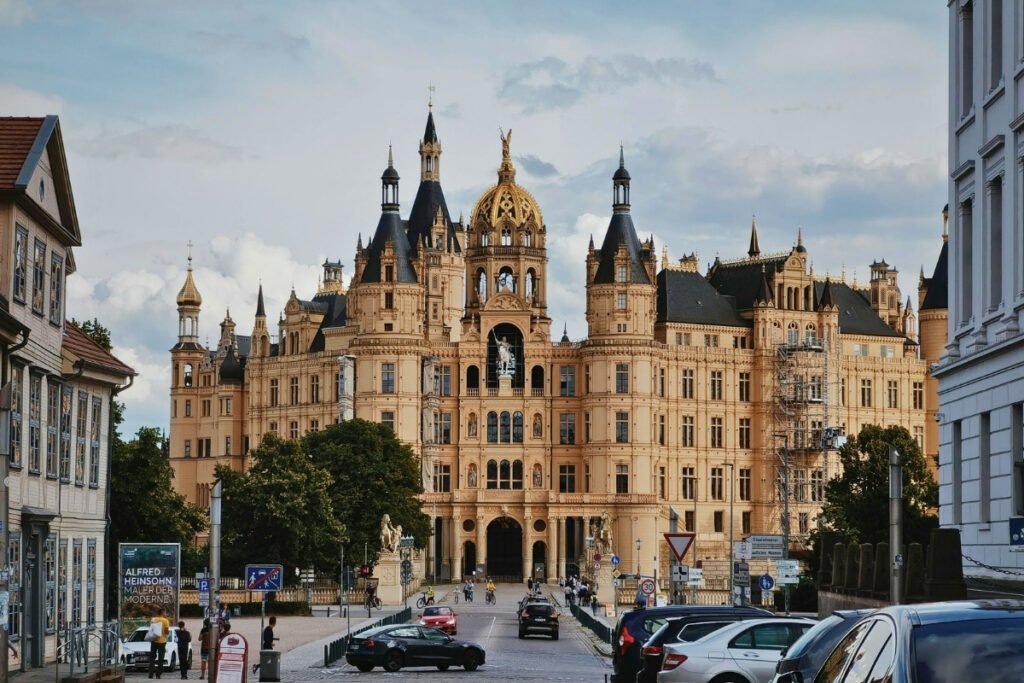
Standing on its own island in Lake Schwerin, the castle feels like it was designed to enchant from every angle. Its reflection shimmers on the water, while spires and domes rise above the treetops, creating one of the most photogenic castle silhouettes in Europe. Schwerin Castle is often described as “fairytale-like,” but its beauty lies in the deliberate blend of styles that tells a story about centuries of ambition, reinvention, and artistry.
A Romantic Masterpiece
The castle’s current appearance is largely the result of its 19th-century reconstruction under Grand Duke Friedrich Franz II. Architect Friedrich August Stüler, with input from Gottfried Semper and others, crafted a Romantic vision inspired by French Renaissance châteaux such as Chambord and Blois. The goal was clear: to create a residence that would rival Europe’s finest palaces.
The result is a masterwork of historicism—a mix of Renaissance revival ornamentation, Baroque flourishes, and Gothic touches. Turrets, gables, and elaborate facades give the castle a sense of movement, as if the structure itself is alive with detail. The central golden dome gleams in the sunlight, acting as both a crown and a beacon, visible from across the lake.
The Exterior: Turrets and Bridges
From the outside, Schwerin Castle looks like a structure made to be admired as much as defended. Dozens of turrets and towers punctuate its skyline, while bridges connect the island to the mainland. Ornamental sculptures, reliefs, and balustrades add to the sense of grandeur. Walk around the perimeter, and the views shift constantly—from sweeping panoramas of the lake to intimate details in the stonework.
The gardens, laid out in Baroque and English landscape styles, complete the scene. Terraces, fountains, and tree-lined paths create a graceful transition between the natural and the architectural. From certain vantage points, the castle seems to float, its reflection merging with clouds and water in a picture-perfect illusion.
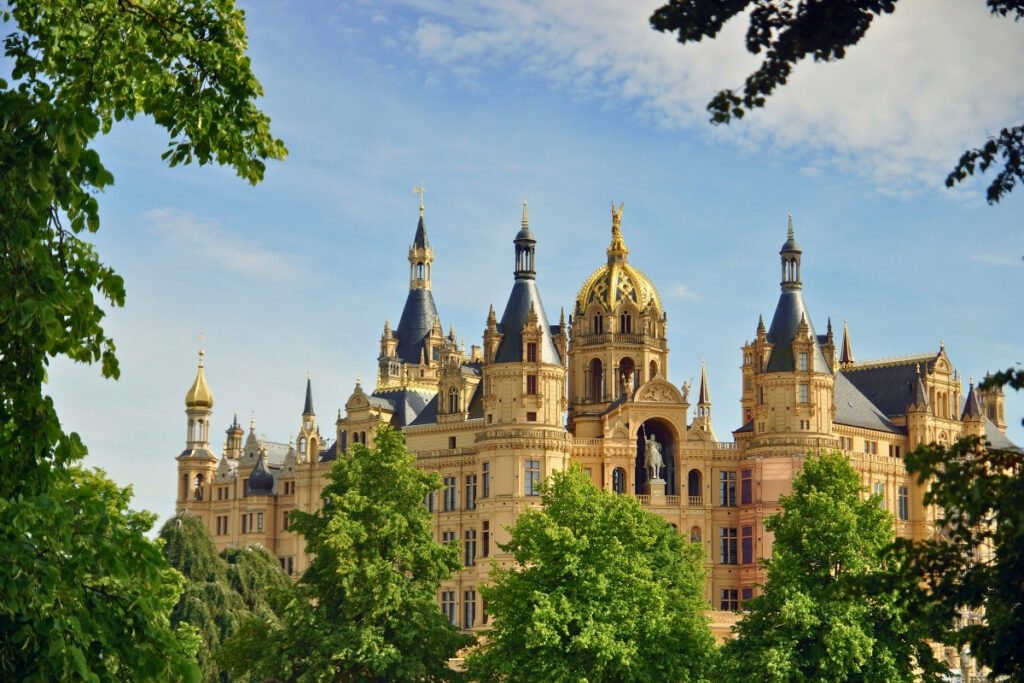
The Interiors: A Palace of Splendor
Inside, the castle is no less impressive. The Throne Room is perhaps the most breathtaking, a chamber adorned with gilded columns, marble, and rich ornamentation. It was designed to impress visiting dignitaries and still does today, with its grandeur speaking volumes about the wealth and power of Mecklenburg’s rulers.
Other highlights include the grand staircases, ballrooms, and galleries, many of which are decorated with intricate woodwork, tapestries, and paintings. Portraits of dukes and grand dukes line the walls, turning corridors into a living family album of Mecklenburg’s rulers. The Chapel, with its stained glass and Gothic revival elements, offers a quieter, more spiritual atmosphere.
Art and Craftsmanship
One of the most striking things about Schwerin Castle is the craftsmanship. Local artisans contributed to its decorative programs, from wrought-iron railings to ceiling frescoes. Everywhere you look, there are details that reward close attention—tiny carvings, painted motifs, and symbolic imagery designed to reinforce the ducal authority.
The castle also housed an extensive collection of art, much of which can still be seen in the museum rooms today. Paintings, sculptures, and decorative arts offer a glimpse into the tastes of Mecklenburg’s rulers, as well as the cultural exchanges between Germany and the rest of Europe.
A Castle in Harmony with Nature
What makes Schwerin Castle stand out among Europe’s great palaces is its relationship with its surroundings. While Versailles dazzles with its scale and Neuschwanstein stuns with its Alpine backdrop, Schwerin feels more intimate. Its island setting makes it seem part of the lake itself, an extension of the water and sky.
Paths along the lake provide some of the best views. From the shore, the castle’s pale walls glow against the dark green of the surrounding forests, while swans drift in the water below. In autumn, golden leaves frame its towers, and in winter, the snow gives it an ethereal, frosted appearance.
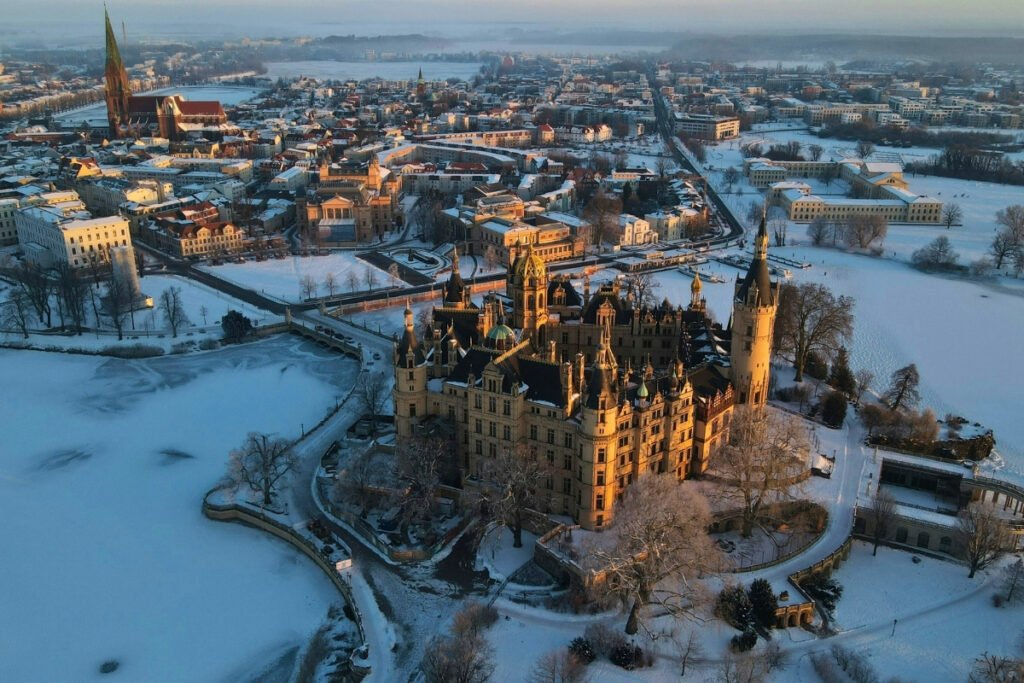
Comparing Schwerin to Other Castles
Schwerin Castle is often compared to Neuschwanstein for its fairytale qualities, but where Neuschwanstein was the personal dream of King Ludwig II, Schwerin represents dynastic continuity—a seat of power that adapted across centuries. Its French inspirations also make it unique in northern Germany, where most castles tend to lean toward fortress-like practicality rather than decorative flourish.
In that sense, Schwerin Castle bridges two worlds: the defensible medieval stronghold and the Romantic palace designed to dazzle. Few places combine both so seamlessly.
Living Architecture
Today, Schwerin Castle is not a relic but a living building. As the seat of the Mecklenburg-Vorpommern state parliament, it continues to shape political life. This modern function contrasts with its historic role but also keeps the castle relevant and maintained. Visitors can walk through museum sections while legislators debate just a few rooms away—a rare chance to see how past and present overlap within the same walls.
From the soaring towers to the gilded interiors, Schwerin Castle is architecture meant to inspire awe. Yet its greatest achievement may be its balance: between fortress and palace, between nature and artifice, between history and modern life. Few castles in Europe embody such harmony, making it not only a fairytale sight but also a deeply human one.

Visiting Schwerin Castle (with real-life tips)
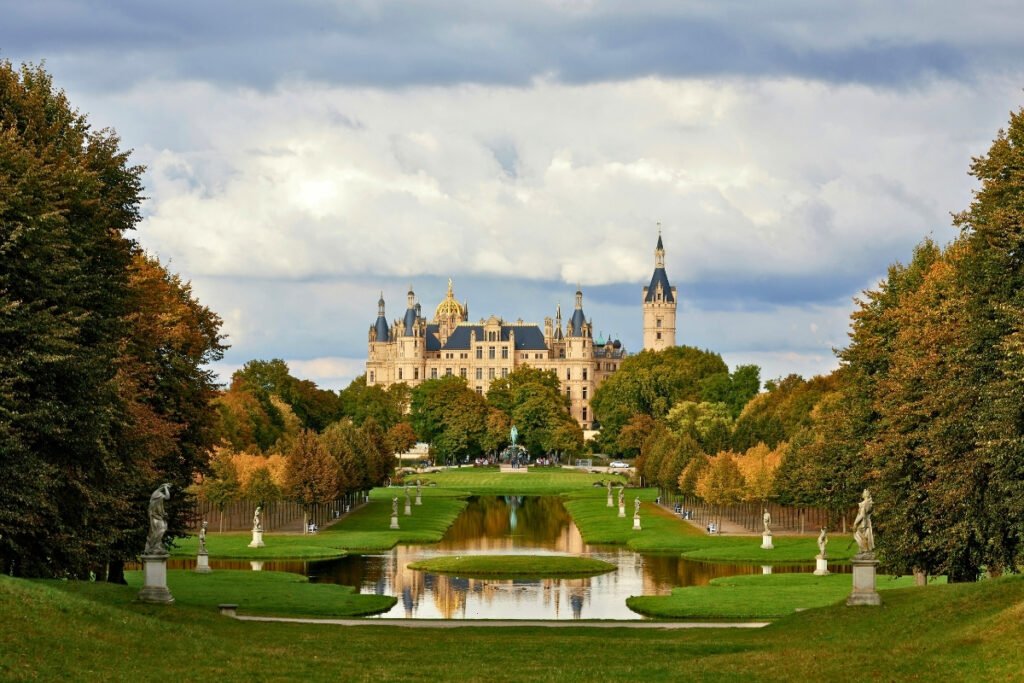
There’s something magical about visiting a castle that seems plucked from the pages of a fairytale, and Schwerin Castle doesn’t disappoint. But unlike some fortresses that are little more than empty shells or overly polished tourist attractions, this one feels alive. It’s a working parliament, a museum, and a cultural landmark, all rolled into one. That means your visit won’t just be about admiring towers and gilded halls—you’ll also experience how this castle fits into the rhythm of daily life in northern Germany.
Here’s everything you need to know for planning a trip that’s smooth, rewarding, and filled with unforgettable moments.
🛣️ How to Get There
Schwerin is the capital of Mecklenburg-Vorpommern, tucked in Germany’s north. It’s not far from Hamburg—about 95 kilometers—and that makes it an easy day trip if you’re based there. Trains run regularly from Hamburg Hauptbahnhof to Schwerin, and the journey takes about an hour and a half. Once you arrive at Schwerin’s central station, it’s a pleasant 20-minute walk to the castle, with plenty of signs guiding you.
Driving is another option, especially if you’re touring northern Germany by car. Parking lots are located near the castle grounds, though they can fill quickly in peak season. If you’re cycling, Schwerin is on several popular bike routes, and riding through the lake region is a peaceful, scenic way to arrive.
Local tip: If you’re coming by train, consider stopping first at Schwerin’s old town on your way to the castle. The cobbled streets, cafes, and half-timbered houses give you a gentle transition before the grandeur of the palace takes over.
🎟️ Entry & Tours
Schwerin Castle isn’t just a museum—it’s also home to the state parliament, so not all areas are open to the public at all times. Still, the accessible sections are more than enough to keep you busy for several hours.
As of 2025, adult tickets cost around €8.50, with reduced prices for students, seniors, and groups. Children under 18 often enter for free. Guided tours, available in German and sometimes English, cost a bit more but are well worth it if you want to dive into the castle’s history and hear stories that aren’t on the information boards.
Inside, the museum sections cover everything from ducal portraits and opulent chambers to displays on regional history. Highlights include the Throne Room, the Chapel, and the grand staircases. Special exhibitions rotate throughout the year, often highlighting art collections, historical events, or connections between Schwerin and other European courts.
Planning tip: Buy tickets online in advance during the summer months. While Schwerin Castle doesn’t see the overwhelming crowds of Neuschwanstein, weekends and festival days can get busy. Booking ahead saves you from queuing, especially if you’re short on time.
📅 Best Time to Visit
Schwerin Castle is open year-round, but the experience changes dramatically with the seasons.
- Spring (April–May): The gardens bloom, the air is fresh, and the lakeside paths are at their prettiest. It’s a quieter time before the summer rush.
- Summer (June–August): Expect longer opening hours and lively events. The annual Schlossfestspiele (castle opera festival) usually takes place in July or August, transforming the gardens into an open-air stage. If you love culture, this is the highlight of the year. But summer also means larger crowds, so plan accordingly.
- Autumn (September–October): Perhaps the most atmospheric time to visit. The golden foliage frames the castle beautifully, and the lake reflections are especially photogenic. Crowds thin out, and the light is softer for photography.
- Winter (November–March): Quieter and colder, but enchanting. A dusting of snow gives the castle a storybook look. While the gardens are less colorful, the interiors are still open and cozy. Winter also offers Christmas markets in Schwerin’s old town, making it a festive trip.
Local tip: If photography is your goal, visit early in the morning or late in the afternoon when the sun casts warm light over the towers. The reflections in the lake are best when the water is still, usually in the early hours.
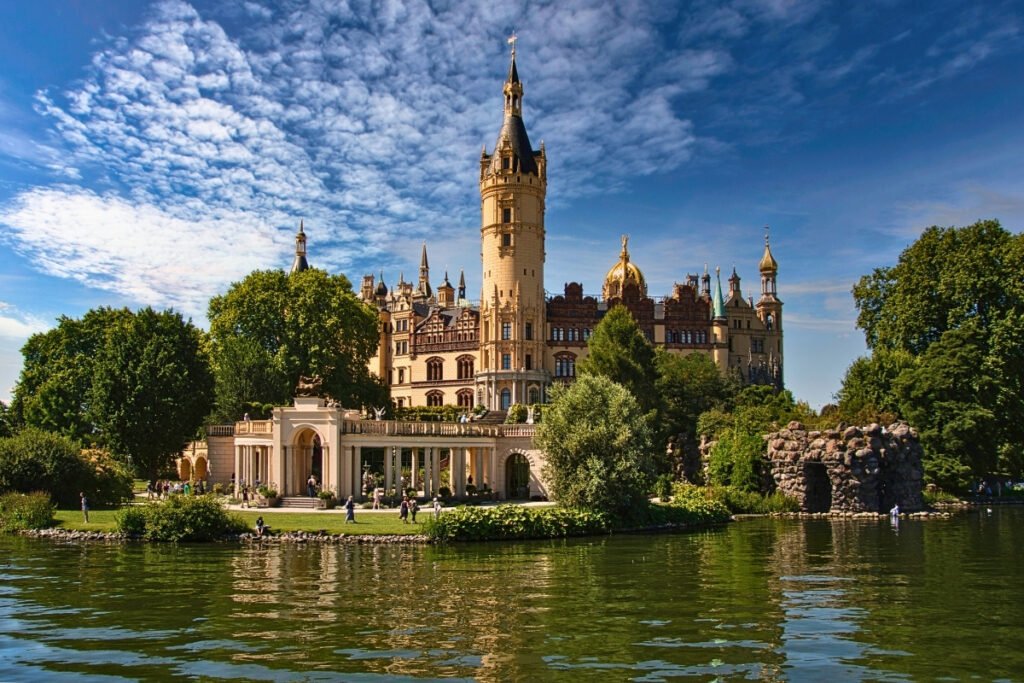
♿ Accessibility & Tips
Schwerin Castle is better equipped for accessibility than many historic sites, though challenges remain due to its age. Ramps and elevators provide access to key areas, and staff are generally accommodating. Still, some narrow staircases and uneven floors in older sections can be tricky. The gardens are mostly accessible, with wide paths and benches for resting.
Facilities include a café, restrooms, and a small shop selling books, souvenirs, and local crafts. The café terrace is a great spot for a break, with views of the gardens and the lake.
A few practical tips from past visitors:
- Wear comfortable shoes. You’ll be walking not only through the castle but also around the gardens and lakeside paths.
- Allow at least 2–3 hours. The museum sections, gardens, and photo stops take longer than you think. If you’re attending the opera festival, block out half a day.
- Bring cash. While tickets and the café accept cards, small vendors around the old town or at seasonal markets often prefer cash.
- Look for the Petermännchen. Even if you don’t believe in ghosts, spotting the little guardian in paintings, statues, and souvenirs is a fun game for kids and adults alike.
Personal Notes
Last time I visited, I arrived just before noon, and the castle was buzzing with a mix of tourists, locals, and school groups. After wandering through the Throne Room and chapel, I took a stroll around the gardens. What struck me wasn’t just the architecture but the way the castle seems to melt into its surroundings. From certain angles, it almost feels like the towers are growing out of the water itself.
Later, I joined a guided tour that included stories about the Petermännchen ghost. The guide swore she once heard footsteps in the empty corridors while locking up after a late shift. Whether true or not, it added just the right amount of intrigue.
And here’s a small but handy tip: if you want one of the best photos, head across the bridge into the town and walk to the banks of the Pfaffenteich Lake. From there, you’ll capture the castle rising above the water, framed by Schwerin’s skyline—a view many visitors miss.
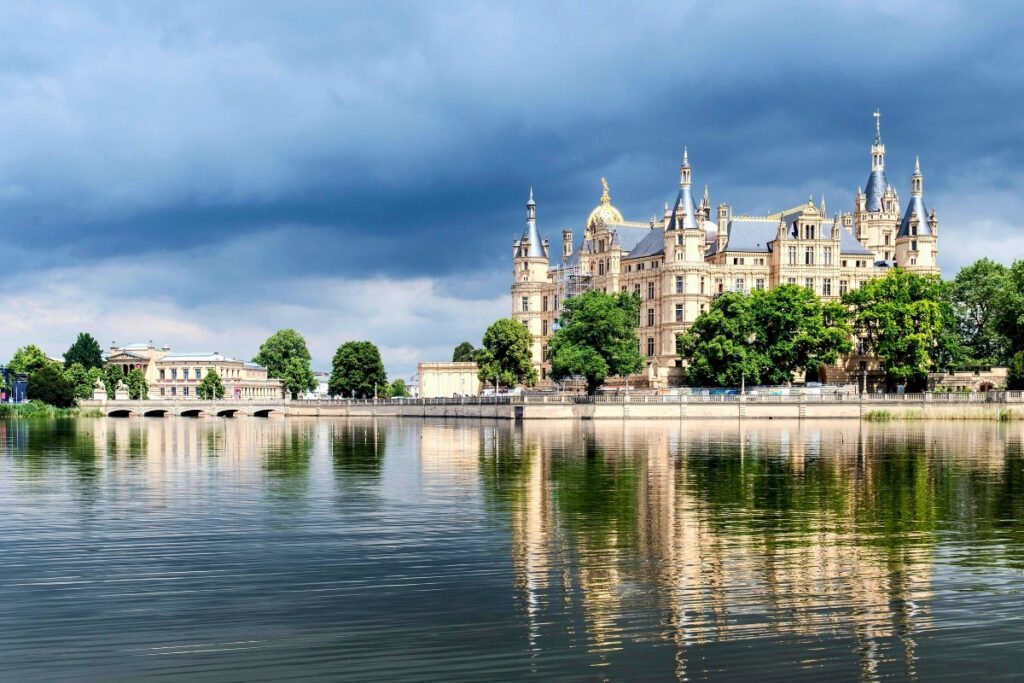
Final Thought on Visiting
Schwerin Castle is not just another stop on a German castle tour. It offers something rare: the chance to step into history while also seeing how that history continues to shape the present. You’ll leave with stunning photos, fascinating stories, and perhaps even a sense of having brushed against something timeless. Whether you spend a quick afternoon here or linger for a full day, the castle rewards every minute you give it.

Nearby Attractions
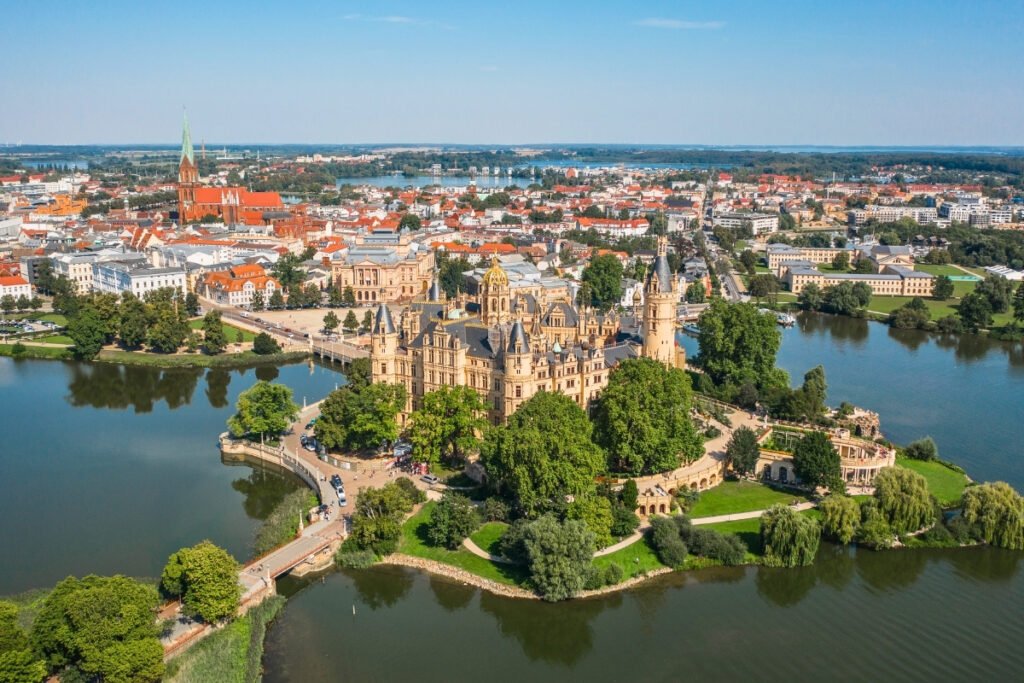
Schwerin Castle may be the jewel of the city, but it isn’t the only reason to linger in this lakeside capital. Within walking distance—or a short drive—you’ll find a handful of spots that make a visit even richer. If you’ve carved out a full day or more, here are places worth adding to your Schwerin itinerary.
Schwerin Cathedral
Just a ten-minute walk from the castle, Schwerin Cathedral dominates the old town skyline with its soaring red-brick Gothic spire, one of the tallest in northern Germany. Built in the 13th century, the cathedral offers a striking contrast to the ornate Romantic style of the castle. Step inside to see stained-glass windows, vaulted ceilings, and a serene atmosphere. If you’re up for a climb, the tower rewards you with sweeping views over the city and its lakes.
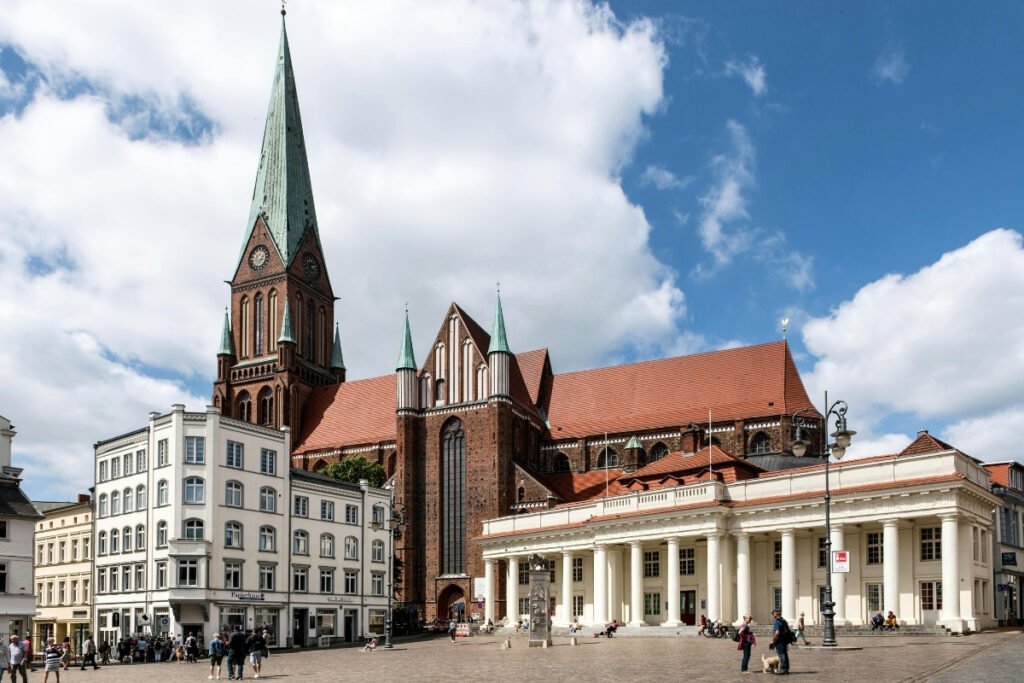
State Museum Schwerin
Directly across from the castle sits the Staatliches Museum Schwerin, a must for art lovers. Its collection includes Dutch and Flemish Old Masters, including works by Rubens and Rembrandt, as well as German Romantic painters. The museum also houses modern art and an impressive collection of porcelain. Paired with the castle’s grandeur, it makes for a perfect cultural double bill.
Pfaffenteich Lake
For a quieter moment, stroll to Pfaffenteich, a rectangular lake lined with 19th-century townhouses. Locals come here to jog, picnic, or simply enjoy the water views. From its northern shore, you’ll get one of the most photogenic perspectives of Schwerin Castle rising above the city. If time allows, stop at one of the cafes around the lake for coffee and cake—an ideal mid-afternoon break.
Schlossgarten and Burggarten
Though technically part of the castle grounds, the gardens deserve special mention. The Schlossgarten, designed in the Baroque style, is filled with manicured hedges, statues, and fountains. The more natural Burggarten offers winding paths and shaded benches along the water. Both are perfect for wandering after your castle tour, especially in spring and autumn.
Ludwigslust Palace (Detour)
If you’re willing to venture about 35 kilometers south of Schwerin, Ludwigslust Palace is a worthy detour. Often called the “Versailles of Mecklenburg,” this Baroque masterpiece sits in vast parkland and boasts ornate interiors. It makes an excellent day trip if you’re basing yourself in Schwerin for longer than one night.
Together, these attractions create a well-rounded experience: art, history, nature, and local flavor all within easy reach of Schwerin Castle. They remind you that the castle isn’t an isolated monument but part of a vibrant cultural landscape.

FAQ – Visiting Schwerin Castle
Where is Schwerin Castle located?
On an island in Lake Schwerin, in the city of Schwerin, Mecklenburg-Vorpommern, northern Germany.
How much time should I plan for a visit?
At least 2–3 hours to explore the museum, gardens, and photo spots. Add more if attending a guided tour or event.
What are the current ticket prices?
As of 2025, adult entry is about €8.50, with discounts for students and seniors. Children often enter for free.
Are guided tours available in English?
Yes, but availability is limited. Check the official website for times, or book in advance during peak season.
Is the castle suitable for children?
Absolutely. Kids enjoy the fairytale towers, spacious gardens, and the legend of the Petermännchen ghost.
Can I take photos inside the castle?
Photography is usually allowed in most museum areas without flash. Tripods and drones are not permitted.
What’s the best spot for castle photos?
From the lakeside gardens, the main bridge, or across Pfaffenteich Lake for a full skyline view.
Is Schwerin Castle accessible to wheelchair users?
Yes, key areas are accessible with ramps and elevators, though some historic sections remain challenging.
When is the best season to visit?
Summer for festivals and events, autumn for golden foliage, and winter for magical snowy scenes.
Does the castle have a ghost?
According to legend, yes—the Petermännchen, a tiny spirit said to guard the castle and play tricks on wrongdoers.
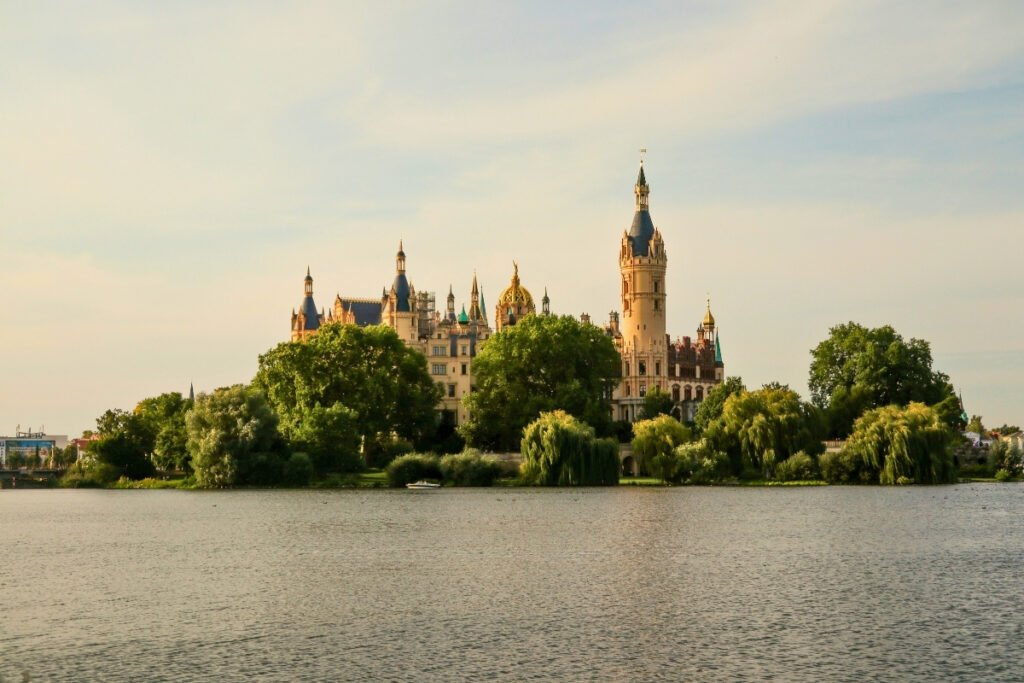

Final Thoughts
Schwerin Castle is one of those places that stays with you long after you’ve left its island. It’s not just the gilded Throne Room or the reflection of its towers shimmering on the lake—it’s the way history, legend, and daily life still intertwine here. You can walk through grand chambers where dukes once ruled, step into gardens designed for royal strolls, then watch locals cross the bridge on their way to work. That balance of grandeur and normalcy gives Schwerin Castle a warmth that sets it apart from many European palaces.
If you’re hunting for the perfect photo, wait until the late afternoon. As the sun dips, the castle glows golden, its silhouette mirrored in the still waters of Lake Schwerin. It’s the kind of view that makes you pause, camera in hand, and simply breathe it in before pressing the shutter.
Whether you’re visiting for the history, the architecture, or just the fairytale atmosphere, Schwerin Castle rewards every kind of traveler. And who knows—maybe you’ll feel a flicker of the Petermännchen’s presence as you wander the halls.
💬 Have you visited Schwerin Castle or another German palace that left you speechless? Share your story with us—we’d love to hear it. And if you’re planning more German castle adventures, don’t miss our guide to the top 10 castles to visit in Germany.
👉 If you’re hungry for more castle adventures, don’t miss our deep dive into the Alcázar of Segovia in Spain or explore our guide to the 10 Best Castles to Visit in Italy, from medieval strongholds to fairytale palaces across the country.
🏰✨Thanks for reading. If you found this article interesting, be sure to follow us along. We are also on Instagram, Facebook, Pinterest, YouTube, TikTok, and X. You can also see all our castle stories here! More castles (and more stories) are on the way.

